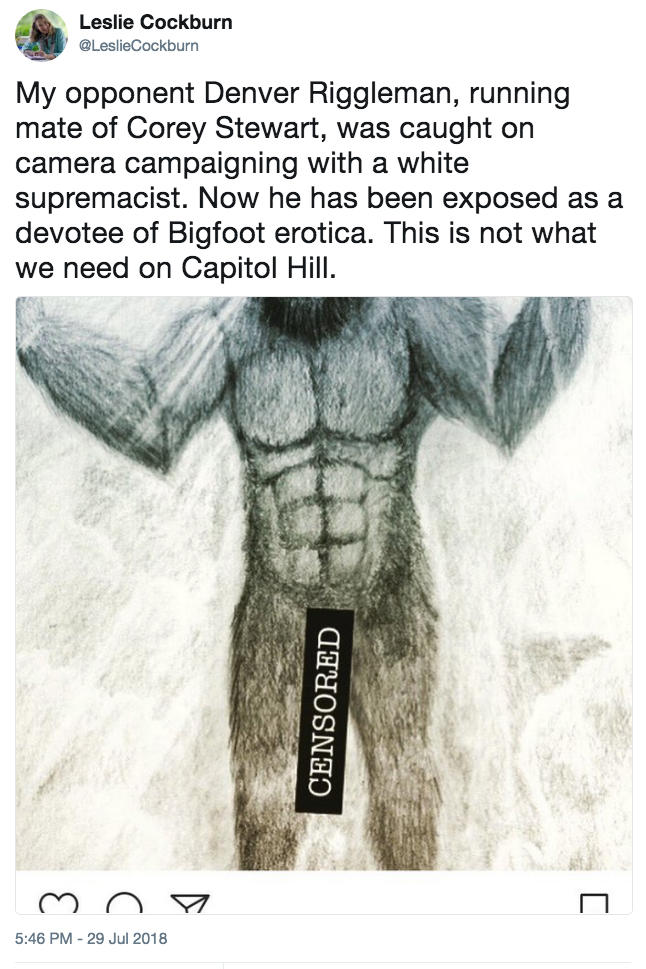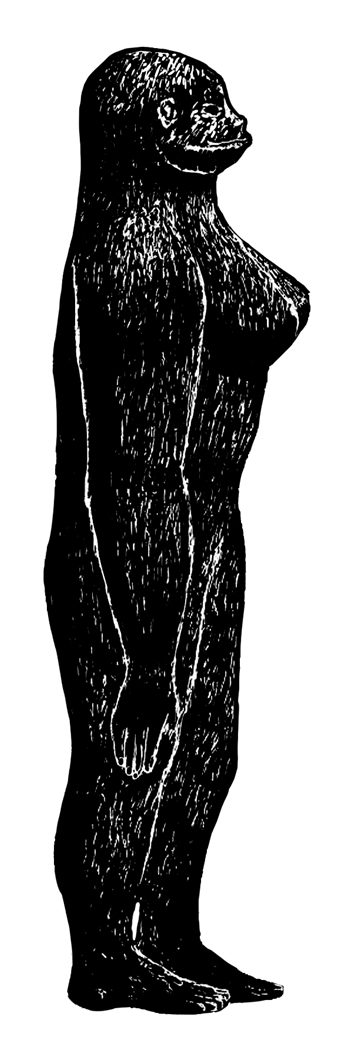Ok, I will fully admit upfront that the article you’re about to read (or: about to stop reading, depending on your preference) is included here both because it’s linked to something in the news, and because it’s sensational and perhaps amusing.
Caption: the offending tweet. What we're all asking is: how anatomically accurate might this depiction be? Spoiler: not accurate at all (err.. assuming that Bigfoot even exists, a minor detail). Image: Twitter.
Without going into all the details, US Republican candidate Denver Riggleman (great name) has been outed as an alleged fan of Bigfoot erotic fiction… yeah, this is a thing, come on you knew that don't pretend you didn't… though I do wonder whether this is some sort of ploy to downplay said candidate’s more worrying association with white supremacists [UPDATE: Loren Coleman tells me that Mr Riggleman has a long-term, serious interest in Bigfootery]. Bigfoot erotic fiction? The fact that – like it or not – Bigfoot is regarded as light-relief and harmless hokum means that any link between Bigfoot and sex is immediately treated as a joke. News stories associated with Riggleman’s niche interests have featured an illustration of a male Bigfoot, its seemingly substantial sexual organ safely censored by a long and subtle black box (see if you can spot it in the image above). And this leads us to the ultimate question: what have people honestly, seriously, thought about the genital anatomy of Bigfoot? Inspired by a twitter exchange with Russ Dobler and Kyle Marian, I thought this was as good an opportunity as any to summarise what’s on the record.
First things first: does this mean that I consider Bigfoot a real, genuine, flesh and blood, undiscovered primate? Let’s just say for now that I’m really sceptical of this notion (for reasons discussed here, and in my 2017 book Hunting Monsters). I’m not a knee-jerk sceptic though, and long to have my mind changed…
Caption: I've only had one up-close encounter with a Bigfoot myself (it happened in California); I didn't have opportunity at the time to do any checking as goes any details of anatomy, but here's the proof. Image: [safely anonymous source]/Darren Naish.
One of the main aims of my writing is to summarise or convey what others have said before me and, like it or not, a bunch of authors who’ve written about Bigfoot as a real biological entity have indeed considered the subject of its genital anatomy. After all, if you regard Bigfoot as a real animal it’s perfectly valid to consider all kinds of aspects of its biology, behaviour and evolution, even if we’re doing little more than speculating.
Caption: if Bigfoot is real, just remember that it's probably the most terrifying animal in existence. Seriously. I tried to modify my drawing (available on merchandise!) so that the animal appears to be in the dark. I failed. Image: Darren Naish.
So, if you look at the Bigfoot literature you’ll see a fair few mentions of male genital anatomy, these most typically being references to “a small penis and scrotum” (Krantz 1999, p. 155). When a penis is mentioned, it’s virtually always flaccid… though there are exceptions. The infamous ‘Kong’ account (in which the semi-anonymous ‘Jan Klement’ described his long-time association during the 1970s with an animal that regularly visited his property) includes an event whereby ‘Kong’ exhibited a tumid penis and interacted sexually with a cow.
Then there’s the ‘Redwoods’ incident. In 1995, an alleged Bigfoot was filmed (from a vehicle) in Jedediah Smith Redwoods State Park, California. And what appears to be a slender, tapering, mobile, sickle-shaped penis flexes upwards during the footage. Some writers have even interpreted this as a possible threat display (Meldrum & Greenwell 1998). This piece of footage is known generally as the ‘Redwoods Footage’, but the fact that it was filmed by a crew working for the Playboy company – and hence is also often called the ‘Playboy Footage’ – hasn’t exactly helped its credibility.
Caption: at left, we see a rather grainy still from the 'Redwoods footage'; at right is an interpretation (drawn by Peter Visscher, based on an initial interpretation produced by Jeff Meldrum). The penis isn't visible in this part of the footage. Image: Meldrum & Greenwell (1998)/BBC Wildlife.
A reasonably large, erect penis has also been described in an observation of a Central Asian bar-manu, one of several creatures sometimes suggested to be Eurasian relatives or versions of North America’s Bigfoot. And then there’s the whole world of speculation concerning whether ancient depictions of satyrs, wildmen and so on with erect penises are relevant to such sightings and their validity. I discuss this issue further in Hunting Monsters (Naish 2017).
Caption: herpetologist and cryptozoologist Jordi Magraner drew this obviously male bar-manu (a crypto-hominid reported from Pakistan) as described by a witness. The account was published by Michel Raynal (2001). Image: Raynal (2001).
Loren Coleman included a whole chapter on sex and genital anatomy in his 2003 Bigfoot! The True Story of Apes in America (Coleman 2003). Indeed, he noted at the start of this chapter that the general absence of writings on Bigfoot sexual behaviour and anatomy seems weird given the importance and significance of these things to primates. “Bigfoot are most frequently shown without any male genitalia even though a penis might be part of a witness description”, he wrote (Coleman 2003, p. 185).
Caption: Loren Coleman's 2003 Bigfoot! includes a whole chapter on ideas and observations about sexual behaviour and anatomy. If Bigfoot isn't real, maybe this stuff is fatuous. Then again, even if Bigfoot isn't real, our attitude to this stuff might still tell us something. And if Bigfoot is real? Well... Image: Simon & Schuster.
A few other eyewitness encounters have described a penis. Albert Ostman – the Canadian logger and construction worker supposedly kidnapped by a Bigfoot family during the 1920s – described the penis of the large male boss of the group as short (around two inches long) and “hooded with skin”, or – according to researcher John Green following his communication with Ostman – “like an inverted funnel, which sounds horse-like” (Coleman 2003, p. 191). I should add for the record that I don’t believe Ostman’s encounter ever happened, strange as that might seem. And the other accounts of which I’m aware refer to an organ proportionally smaller than that of an average human – there aren’t (so far as I’m aware) reports of giant, swinging structures of impressive length or girth, excuse the mental image.
The general impression we get from this limited information (assuming here that Bigfoot is real, of course) is somewhat contradictory but we can couch what we know within the social systems and breeding strategies of other primates (e.g., Harcourt & Gardiner 1994). Because there’s no indication of giant testes (like those of chimps), we might infer that sperm competition is not an evolutionary driver for Bigfoot, and thus that they presumably have a monogamous or near-monogamous mating system. This is in keeping with the general idea that Bigfoot lives in small bands, perhaps involving a mating pair and their offspring. The apparently proportionally small size of the penis could be seen as being consistent with this, since it might indicate that the genitals are not used in social display and intimidation, as they are in humans and (to a degree) chimps and bonobos. On the other hand, a proportionally small penis could also be inconsistent here, given the hypothesis that large penises in humans are supposedly linked with monogamy/near-monogamy (note: supposedly. I must avoid discussing the argument over human sexual behaviour and mating systems). The contradiction comes from the Redwoods footage, though, since this seemingly reported a relatively large penis used as a display, err, tool.
I will finish this discussion on male genitals by noting that there’s been some serious discussions within Bigfoot research circles as goes such details of anatomy as the presence or otherwise of the baculum. You can read about that discussion, if you wish, in this 2010 article by Loren Coleman.
Caption: the creature in the Patterson-Gimlin footage of 1967 – now affectionately known as 'Patty' within the Bigfoot research community – seemingly has breasts comparable to those of some humans. Is it coincidental that Roger Patterson was very familiar with William Roe's female Bigfoot of the 1950s (see below)? Or is this consistent with the ostensible biological reality of this animal? Because images of the Patterson-Gimlin film are copyright protected (like virtually all images of Bigfoot), I made this myself and it's available for use. Image: Darren Naish.
So that’s enough of that. Everything you’ve read so far is focused on males of this ostensible species. What about females? I think it would be fair to assume that very little – perhaps nothing – has been written about female anatomy. Bigfoot is, after all, mostly imagined as a quintessentially male creature linked to masculinity and the manly male humans that pursue it. But female Bigfoots have been reported too, and indeed among the most influential and historically significant of all Bigfoot accounts ever – William Roe’s Canadian story of the mid-1950s and Roger Patterson and Bob Gimlin’s famous/infamous encounter of 1967 – describe obvious females.
Caption: late in the 1950s, William Roe reported his encounter (supposedly from earlier in the decade) with another obviously female Bigfoot in Canada. This drawing was produced by Roe's daughter, under his direction. I can't be the only one who thinks the anatomy here is a bit... gravity-defying. This is not the original drawing, but a re-drawing produced by John Conway for our 2013 book The Cryptozoologicon: Volume One. Image: John Conway.
Breasts have been written about and commented on a great many times in discussions of this creature. A few reports have described elongate or ‘droopy’ breasts but those most often discussed – those of ‘Patty’ and Roe’s creature – were rotund and even engorged in appearance (Bindernagel 1998). Indeed, those working to demonstrate the reality of the Patterson-Gimlin film have gone to some trouble to argue that ‘Patty’s’ breasts can’t be fake because they exhibit movement and flexibility consistent with genuine breasts, and inconsistent with any of the available prosthetic alternatives. William Munns has a whole section on this issue in his book When Roger Met Patty (Munns 2014). Human models were filmed and photographed to show, via comparison, how the ‘Patty’ breasts perform in a consistent and realistic manner.
I could go on – as I’ve said, a lot has been said about Bigfoot breasts in the literature (there’s also been a whole discussion on how realistic the concept of furry breasts might be) – but I think that’ll do. Moving elsewhere as goes females, why do we never hear about female genitalia (I’m here excluding breasts from the definition of ‘genitalia’), in contrast to all those mentions of Bigfoot junk? Maybe it’s true that those who’ve considered Bigfoot as a biological entity have been biased by patriarchy. I don’t doubt that this is true but it should also be noted that observations and recollections concerning the finer details of female genital anatomy are few and far between, as they might be for logical reasons (I mean: all the goddam hair). Anyway, a few mentions are out there. A very few.
In the aforementioned discussion provided by Loren Coleman, Loren refers to the rarity of discussions of female genital anatomy and notes that he (at the time) was only aware of one. In the November of 1968, hunter John Thomas is said to have encountered two Bigfoots sleeping out in the open. They were in the posture that – curiously enough – has been described on several occasions by witnesses; that is, with the limbs partially folded beneath the body and the back facing upwards. Anyway, one of these animals had breasts in addition to a “swelling” in its genital region that it kept rubbing (Coleman 2003, p. 198). Without more information it’s difficult to know the story here. Presumably we’re talking about a modest swelling of the sort seen in various primates (including gibbons and gorillas among hominoids), and not the pronounced and striking structures seen in chimps, bonobos and various monkeys.
Caption: several accounts describe crypto-hominids sleeping in this very unusual posture, or at least in postures like it. This drawing was apparently produced by a Soviet zoologist called Khlakhlov during the early 1900s and depicts an Almas – an Asian crypto-hominid – encountered in the Dzungarian region. The drawing is reproduced in Myra Shackley's 1983 book. Image: Shackley (1983).
A second case concerns what’s said to be the imprint of a Bigfoot butt, left in sandy soil in Walla Walla, Washington. The print was cast by Paul Freeman – an individual with a controversial track record in the world of Bigfoot evidence, shall we say – and passed to Jeff Meldrum who described it in his 2006 book. The print reveals well demarcated, muscular buttocks but also what appears to be the suggestion of labia (Meldrum 2006). With a bit of imagination, they look – from the cast of the impression – to be about similar in form and proportion to those of a human.
Needless to say, there isn’t – to my knowledge – any discussion out there as goes any other aspects of female genital anatomy in this alleged creature. Not only is eyewitness data on such details unreported (so far as I know), but any sensible idea we might have on what’s predicted or assumed is dependent on whatever phylogenetic affinity we prefer for the species: Bigfoot has, variously, been suggested to be close to gibbons, orangutans, hominines and even hominins and humans by those who endorse its existence. There's an argument for platyrrhine status out there as well.
Caption: non-human primates of many sorts have diverse and remarkable genitals. Variously platyrrhines – spider monkeys are the most famous – have enormous clitorides. This is a Colombian or Black-headed spider monkey Ateles fusciceps rufiventris using a stick as a scratching tool. Image: Darren Naish.
That about brings us to a close on this niche yet worthy subject. As usual with arcane topics like this, it’s never true that “nobody ever talks about ---- [insert weird niche subject]”: on the contrary, quite a few writers have. Clearly, if Bigfoot is real, we have scant data to work with, and a conclusion must be that Bigfoot genitalia are not especially noticeable in average encounters with humans. And if Bigfoot isn't real, but is a sociocultural phenomenon of some sort, the fact that so few encounters discuss its genitalia in detail might be consistent with the near-irrelevance of such features to an entity of this sort. This might be inconsistent with erotic fan fiction – sorry, Mr Riggleman – but there it is.
For previous Tet Zoo articles on Bigfoot and other cryptozoological matters, see…
Cryptozoology at the Zoological Society of London. Cryptozoology: time to come in from the cold? Or, Cryptozoology: avoid at all costs?, July 2011 (ruined by hosters: no longer includes pictures)
The Cryptozoologicon (Volume I): here, at last, December 2013 (ruined by hosters: no longer includes pictures)
Is Cryptozoology Good or Bad for Science? (review of Loxton & Prothero 2013), September 2014 (ruined by hosters: no longer includes pictures)
My New Book Hunting Monsters: Cryptozoology and the Reality Behind the Myths, February 2016 (ruined by hosters: no longer includes pictures)
If Bigfoot Were Real, July 2016
Refs - -
Coleman, L. 2003. Bigfoot! The True Story of Apes in America. Paraview, New York.
Conway, J., Kosemen, C. M. & Naish, D. 2013. Cryptozoologicon Volume I. Irregular Books.
Harcourt, A. & Gardiner, J. 1994. Sexual selection and genital anatomy of male primates. Proceedings of the Royal Society, London B 255, 47-53.
Krantz, G. S. 1999. Bigfoot Sasquatch Evidence. Hancock House, Surrey, B.C. & Blaine, WA.
Meldrum, D. J. 2006. Sasquatch: Legend Meets Science. Tom Doherty Associates, New York.
Meldrum, J. & Greenwell, R. 1998. Bigfoot: take two. BBC Wildlife 16 (9), 68-71.
Munns, W. 2014. When Roger Met Patty. William Munns.
Naish, D. 2017. Hunting Monsters: Cryptozoology and the Reality Behind the Myths. Arcturus, London.
Raynal, M. 2001. ‘Jordi Magraner’s field research on the bar-manu: evidence for the authenticity of Heuvelmans’ Homo pongoides.’ In Heinselman, C. (ed) Hominology Special Number 1. Craig Heinselman (Francestown, New Hampshire), unpaginated.
Shackley, M. 1983. Wildmen: Yeti, Sasquatch and the Neanderthal Enigma. Thames and Hudson, London.


![I've only had one up-close encounter with a Bigfoot myself (it happened in California); I didn't have opportunity at the time to do any checking as goes any details of anatomy, but here's the proof. Image: [safely anonymous source]/Darren Naish.](https://images.squarespace-cdn.com/content/v1/510be2c1e4b0b9ef3923f158/1533161346909-MMK41T4JOD99AEY17TJ4/Bigfoot-in-LA-572-px-tiny-Aug-2018-Darren-Naish-Tetrapod-Zoology.jpg)











